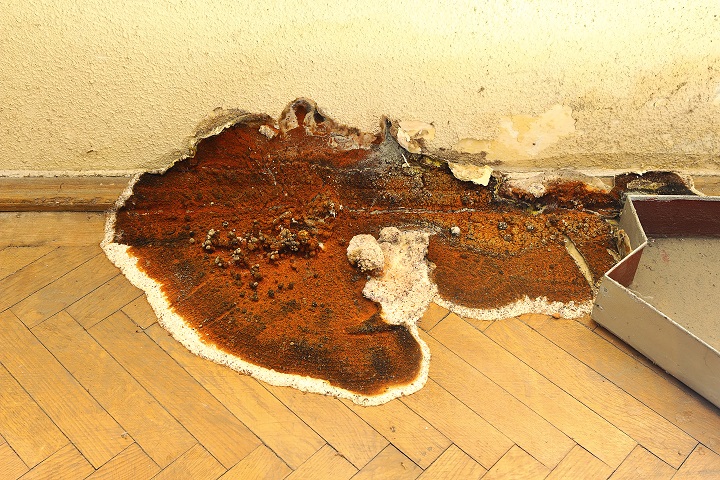Blog
Dry Rot FAQs

Dry rot is a form of fungal decay that attacks timber and digests the strength-providing parts of the wood. Though it’s common knowledge that dry rot is detrimental to the structural integrity of a building, for many of us, the knowledge ends there. We’re all aware that dry rot needs treating, but what does this entail? How do you identify it? Why does it occur? These are just a handful of the many queries that leave people scratching their heads when it comes to dry rot. As a result, we’d like to answer these questions for our customers.
Here at Garratts Damp, we’re conscious about providing a transparent service, and this can’t be done if our customers are unfamiliar with dry rot. We like to ensure that our customers are aware of what we’re doing to their homes at all times. We understand the level of trust that it takes to leave your home in the hands of someone else and want to ensure that we provide an honest service.
How Do You Identify Dry Rot?
First thing’s first, you’ll need to know how to detect dry rot. Ahead of dry rot mycelium, you likely won’t be able to identify dry rot. However, once the rot reaches this stage, you’ll be able to spot fluffy mycelium, a whitish-grey skin on wood, mushroom-like fruiting bodies (sometimes large brackets) and red dust (spores). On top of this, cracking wood, shrinking timber, crumbly wood, and darker timber can also indicate the presence of dry rot. Sometimes the first sign can be cracking of paintwork on skirtings and architraves.
Does Dry Rot Smell?
Typically speaking, dry rot will have an earthy, mushroom-like, musty, or damp odour.
Why Does Dry Rot Occur?
Dry rot spores are present in the atmosphere, although they’re only likely to cause problems in damp conditions. Usually, this issue will present itself in the instance of leaking downpipes and gutters, penetrating damp, poor ventilation, and rising damp.
What is the Dry Rot Wood Treatment?
If you’ve detected dry rot in your home, your next port of call is fixing the dry rot. Firstly, the source of moisture will need to be located and amended. Next, the severity of the outbreak will need to be established by opening the damaged area and stripping back all plaster and render. Once this has been determined, the damaged wood will need to be cut back, whilst all spores and fruiting bodies will require removal. After this, the walls will need to be cleaned of surface growth. Finally, the wood will require replacement using pre-treated timber in prevention of recurring infestations.
Can You Treat Dry Rot Yourself?
You cannot treat dry rot yourself and should always bring in a professional to carry out this work.
Do Wood Rot Treatment Sprays Work?
Wood rot treatment sprays do not work in the instance of dry rot. This is why it’s so important to contact a professional about this problem.
Will Dry Rot Go Away on Its Own?
Dry rot will not go away on its own; instead, it will continue to spread and feed on the wood in your home. This is detrimental to your home’s structural integrity and should be treated as a matter of urgency. Even if the water source is removed, the spores will remain dormant waiting for the next ingress of water to burst back into life, it cannot remain untreated.
How Quickly Does Dry Rot Spread?
The spread of dry rot depends on the conditions of your home. If your house is particularly warm and moist, this creates a breeding ground for dry rot.
Is Dry Rot Bad for Your Health?
Dry rot spores alone aren’t cause for concern when it comes to health risks. Despite this, dry rot does indicate an underlying damp issue or excessive moisture, which can be damaging to your health. This is particularly true if mould is present.
Is Dry Rot a Mushroom?
Despite its appearance of a fruiting body, dry rot is not a mushroom. Instead, dry rot is a form of fungal decay that damages the wood in a property and weakens the building’s structure.
Is Dry Rot Covered by Insurance?
Whether the presence of dry rot is covered by your insurance depends on your insurance provider. Some insurance providers will consider dry rot as wear and tear, meaning that they’re not liable to cover the cost of any damage. However, this isn’t a general rule, so it’s important to check with your insurance provider.
Our experience suggest that leaking gutters and downpipes are wear and tear and thus not generally covered in policies, however, leaking plumbing pipes hidden from view behind boxwork or timber suspended floor may be covered.
What is the Difference Between Dry Rot and Wet Rot?
Both dry rot and wet rot are forms of fungal decay that affect the wood in your home. Despite this, dry rot is regarded as more unique, and also more destructive, than wet rot. This is because it’s able to travel in spores through the air.
Contact Garratt’s Damp for Dry Rot Treatment
Here at Garratt’s Damp, we offer a site survey, meaning that we’ll be able to provide a no obligation quote upon analysing your property’s issue. Contact us to get in touch with a professional and learn more about our services.
Archived Articles
Recent
-
18 Mar 2024
How to Get Rid of Damp in Bedrooms
While it may seem more logical that kitchens and bathrooms are more prone to damp, it may be surprising for…
-
13 Nov 2023
Benefits of Tanking Your Basement
While basements have been a staple of home construction in multiple countries, they are still a relatively new concept in…
-
13 Nov 2023
Taking Action on Fixing Damp
Damp is a widespread problem in properties across the UK; however, this doesn’t stop the fact that it’s a serious…







